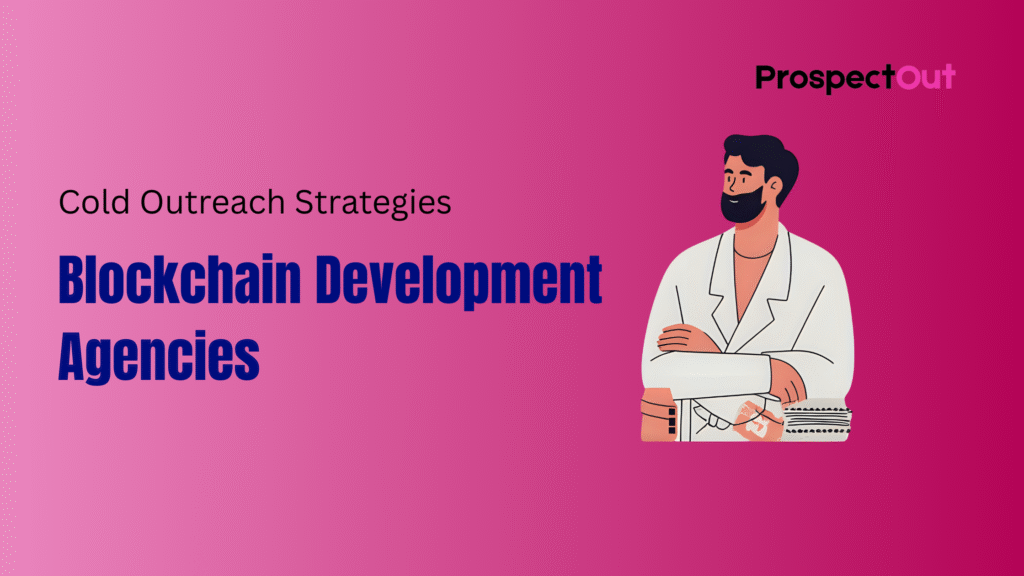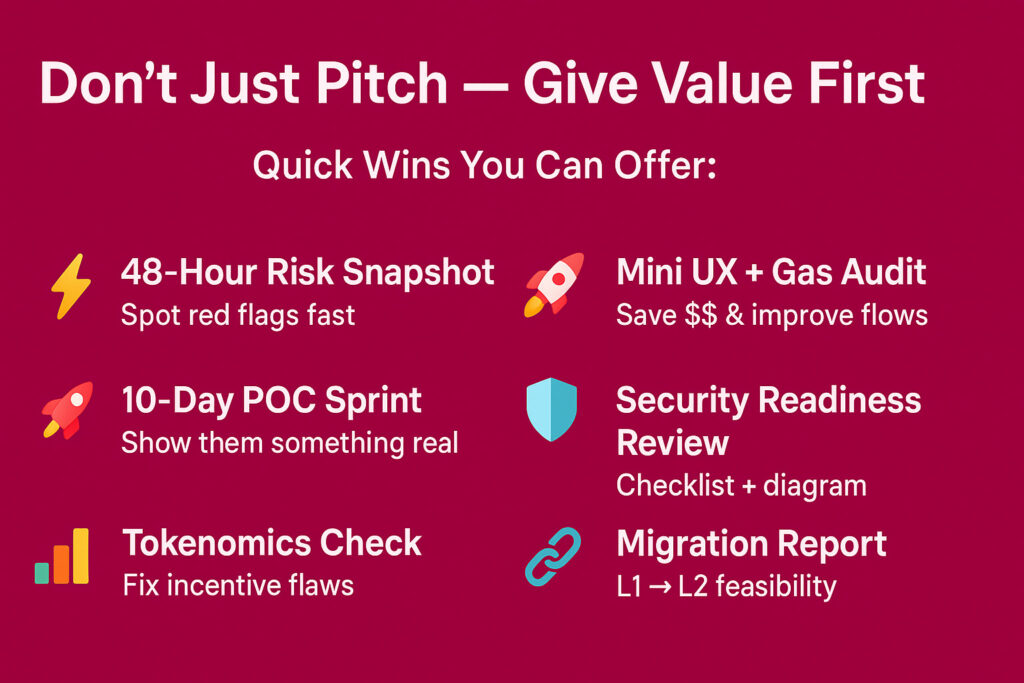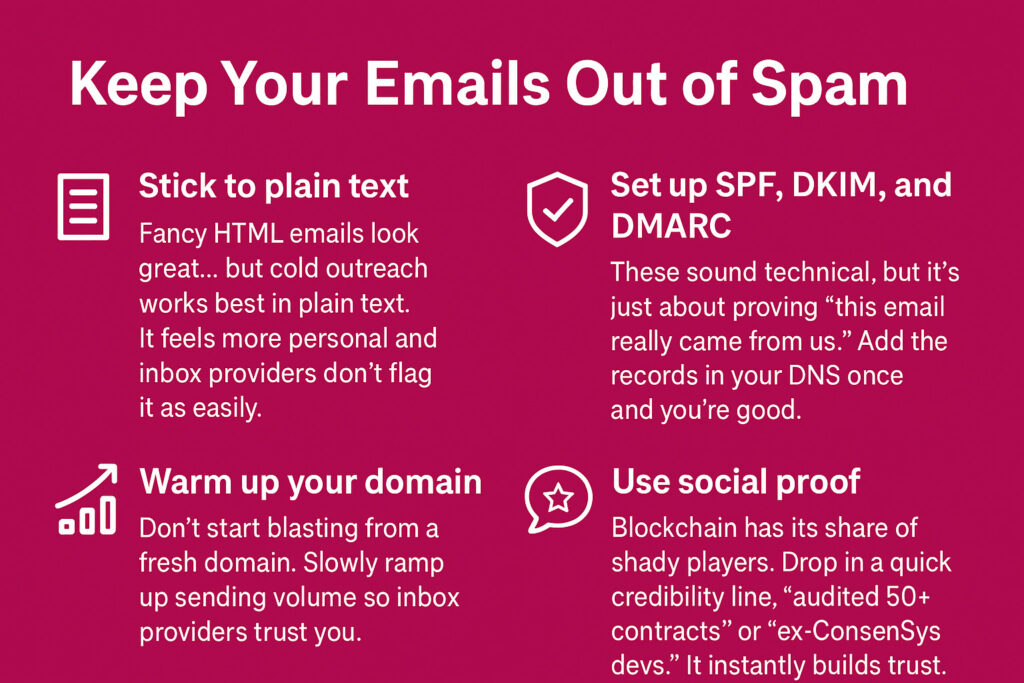
Finding clients for a blockchain development agency isn’t always easy. You’ve got the dev skills, the smart contract expertise, maybe even a few case studies under your belt… but how do you consistently get new projects rolling in?
That’s where cold outreach comes in. And no, I don’t mean blasting 1,000 generic emails that end up in spam. I’m talking about smart, personalized outreach that actually gets replies, builds trust, and lands you meetings with the kinds of clients who pay well for blockchain work.
In this guide, we’re going to break it all down: who you should target, what kind of offers make people respond, how to write outreach emails that don’t feel salesy, and even the technical stuff (like making sure your emails don’t land in spam).
By the end, you’ll have a clear playbook to generate leads for your blockchain dev agency in a way that feels natural and works in 2025.
Why This Matters (And What You’ll Get Here)
If you run or work with a blockchain development agency, you already know the struggle: amazing tech, brilliant devs… but how do you actually get new clients through the door?
Most folks default to ads, networking, or hoping inbound leads show up. But cold outreach one right.
It remains one of the fastest ways to launch blockchain projects. The trick is making it feel less like spam and more like an actual value-driven conversation.
That’s what we’re going to unpack here: who you should be reaching out to, what you should offer, how to structure emails and sequences, and how to keep your messages out of the spam folder. Think of this as a practical playbook you can swipe and adapt.
Know Who You’re Talking To (Your Ideal Client Profile)
Not every company waving the “we’re interested in blockchain” flag is worth your time. Focus on the ones that actually budget for development:
- Fintech & payments – banks and startups exploring stablecoins, tokenization, faster settlements like ai development.
- Consumer brands & loyalty programs – using NFTs or on-chain tokens for rewards and memberships.
- Supply chain & manufacturing – companies needing traceability and compliance reporting.
- Gaming & digital assets – play-to-earn economies, in-game marketplaces, NFT collections.
- Healthcare & identity – verifiable credentials, medical record security, compliance-heavy systems.
- Funded web3 startups – fresh off a seed or Series A round, now looking for dev firepower.
Who’s holding the checkbook?
It’s usually one of these:
- CTOs or Heads of Engineering (they care about security and scalability).
- Heads of Product/Innovation like animation agency (they’ve got budget for pilots).
- Operations/Compliance leaders (traceability and audits).
- Startup founders themselves (they just raised money and need to build fast).
How do you know they’re in-market?
A few signals that a company’s worth reaching out to:
- They just announced funding.
- They’re hiring Solidity/Rust developers.
- They released a partnership press release.
- Their GitHub or contracts just got busy.
Don’t Just Pitch—Offer Something Valuable
Here’s the part most agencies get wrong: nobody wants an email saying “Hey, we build on Ethereum, let’s hop on a call.” That’s noise.
Instead, lead with something useful. A little freebie that shows you know your stuff and makes the person think, “huh, maybe I should talk to them.”

Value-first offers that work
- 48-Hour Smart Contract Risk Snapshot – give them 2–3 security red flags you spotted. Make it clear it’s not a full audit.
- dApp UX & Gas Optimization Mini-Audit – 3 UX improvements + 2 ways they can save on gas.
- 10-Day POC Sprint – deliver something tangible, like an NFT loyalty pilot or walletless onboarding flow.
- Architecture & Security Readiness Review – Diagram + Launch Checklist to help them feel safer shipping.
- Tokenomics Sanity Check – highlight incentive flaws in their system before it becomes a PR disaster.
- Migration Feasibility Report – show what it would take to move from L1→L2 or chain-to-chain.
The point isn’t to give away the farm. It’s to prove you’re worth paying.
Build a Cold Outreach System For Blockchain Development Agencies
Personalization is non-negotiable
Forget blasting the same message to 500 people. In blockchain, trust is everything. So research before you send. Check:
- Their GitHub repos or contract deployments.
- Their funding announcements.
- Their community (Discord/Twitter/Telegram).
- Their job postings.
Drop one of those details in your email and suddenly you’re not just another cold stranger. You’re someone who actually did the homework.
Mix your channels
Email is still king, but in web3, people also live on:
- LinkedIn – especially for enterprise blockchain deals.
- Telegram & Discord – perfect for startups and web3-native projects.
- Twitter (X) – a lot of projects announce updates here first.
A simple sequence could look like this:
- Email (value-first offer).
- LinkedIn view + connect request.
- Telegram DM (if they’re active there).
- Follow-up email with a teaser finding.
- Breakup email (“want me to circle back later?”).
Timing matters more than you think
Most studies agree:
- Early week works best (Tuesday/Wednesday).
- Late mornings tend to get higher reply rates.
- Always test and track what works for your audience.
Cold Email Templates You Can Steal
Security angle (for startups)
Subject: quick security gut-check on your contracts
Hi {{FirstName}},
Noticed {{Project}} is gearing up for {{milestone}}. I ran a quick pass on {{repo/contract}} and saw a couple of things worth looking at (like {{finding}}).
I can share a 3-item risk snapshot with examples + suggested fixes. 48 hours, no cost. Want me to send it over?
– {{YourName}}
UX & gas optimization (for dApps)
Subject: 5 quick wins to lower {{Project}}’s gas fees
Hey {{FirstName}},
Checked out {{dApp/flow}}. I spotted a few UX tweaks and at least one optimization that could cut gas by {{X%}}.
I can put it in a short PDF this week interested?
— {{YourName}}
Enterprise loyalty pitch (for brands)
Subject: pilot idea to cut loyalty costs by {{X%}}
Hi {{FirstName}},
We recently helped a retail brand run a wallet-free loyalty pilot that cut fraud and improved redemption tracking.
If it’s helpful, I can draft a 10-day POC plan for {{Brand}} so you can see what it looks like—no obligation.
Should I?
– {{YourName}}
Keep Your Emails Out of Spam
Nothing kills momentum like your carefully written email landing in the spam folder. Luckily, avoiding it is pretty straightforward:

Stick to plain text
Fancy HTML emails look great… but cold outreach works best in plain text. It feels more personal and inbox providers don’t flag it as easily.
Set up SPF, DKIM, and DMARC
These sound technical, but it’s just about proving “this email really came from us.” Add the records in your DNS once and you’re good.
Warm up your domain
Don’t start blasting from a fresh domain. Slowly ramp up sending volume so inbox providers trust you.
Use social proof
Blockchain has its share of shady players. Drop in a quick credibility line, “audited 50+ contracts” or “ex-ConsenSys devs.” It instantly builds trust.
Where to Find the Right Prospects
- LinkedIn + Sales Navigator – filter by “Head of Innovation” at Fintechs, or “Blockchain” in job posts.
- GitHub & on-chain explorers – see who’s actively shipping code.
- Crypto events & communities – Telegram groups, Discord servers, web3 hackathons.
- Funding announcements – Crunchbase, PRNewswire, even Twitter threads. Funded teams need to spend.
Real-Life Messaging Examples
Fintech pilot (enterprise buyer)
Skip the blockchain jargon. Instead of “We’ll build you an Ethereum-based settlement system,” say:
“We can help you test a faster settlement pilot that reduces transaction fees by 20%.”
Startup security angle
Use the “risk snapshot” as your hook. Show them you’ve identified a technical issue. They’ll almost always bite.
Loyalty POC (consumer brands)
Offer a 10-day build that proves out NFT-based loyalty without requiring customers to manage their own wallets. Less tech talk, more ROI talk.
KPIs and When to Scale
At the start, don’t obsess over hitting 50% open rates or 15% replies. Cold outreach is about testing. Here are some benchmarks to aim for:
- Open rates: 40–60%
- Reply rates: 8–15%
- Positive replies: 2–5%
Once you start seeing consistent replies, you can scale by:
- Adding more inboxes (on different domains).
- Expanding into Telegram/Discord touches.
- Testing new offers (risk snapshots, audits, POC sprints).
Launch Your First Campaign in 7 Days
Day 1–2
Set up your domain, including SPF/DKIM/DMARC, and use a warm-up tool. Start building your ICP list.
Day 3–4
Research 50 top-fit prospects. Draft your value-first offers.
Day 5
Send the first batch of 50 emails (keep them plain text).
Day 6–7
Follow up, track opens and replies, tweak your copy.
By the end of the week, you’ll have data to improve. And once you land that first call, you’ll realize cold outreach isn’t about spamming strangers. It’s about proving value fast and starting real conversations.
Final Thoughts
Here’s the thing: blockchain development is booming, but buyers are more skeptical than ever. If you want your outreach to work, don’t act like a salesperson. Act like a partner who shows up with something useful before asking for their time.
That’s the fastest way to turn cold strangers into warm leads. And eventually, paying clients.


